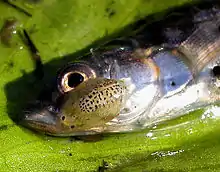Branchiura
Branchiura is a group of crustaceans ranked as a subclass of Maxillopoda.[1] They were once thought to be Copepods before becoming their own distinct subclass.[2] Branchiurans are commonly known as fish louse or fish lice if plural.[1] Branchiurans are ectoparasites that are found primarily on fish, but can also be found on other aquatic organisms such as invertebrates and amphibians.[1] Some species feed on the blood of their host, while others feed on mucus and extracellular material.[2] Typically the parasites wait two to three weeks before feeding again.[2]
| Branchiura | |
|---|---|
 | |
| Argulus sp. on a stickleback | |
| Scientific classification | |
| Kingdom: | Animalia |
| Phylum: | Arthropoda |
| Subphylum: | Crustacea |
| Class: | Maxillopoda |
| Subclass: | Branchiura Thorell, 1864 |
| Orders | |
Anatomy
Branchiurans are composed of an oval carapace, four pairs of swimming legs, a pair of anterior compound eyes, and an unsegmented abdomen.[1] They are also compressed dorsoventrally and can be between two and thirty millimeters in length.[1] In the genera Argulus, Chonopeltis, and Dipteropeltis, the adults have a pair of suction cups that are from modified first maxillae.[1] The genus Dolops, keeps the larval stages claw-like appendages into adulthood.[1] Also, females tend to be larger than the males.[1] Between the genera there are multiple distinction between the sexes.[1] For example, males in Argulus and Chonopeltis possess secondary sexual modifications on legs 2-4.[1] The sexes both have their own sexual reproductive organs on their abdomens.[1] The females have a spermathecae, while the males have a pair of testes.[1]
Reproduction
While on their host, Branchiurans mate.[1] The spermathecae on the female stores the sperm.[1] In the genus Dolops, the males deposit a spermatophore onto the females.[1] Once the eggs are fertilized the females leave the host organism to lay their eggs on surfaces of plants, rocks, etc.[1] The female holds the eggs in the thorax and in some species the eggs can be found inside lobes of the carapace.[1]
References
- Poly, William J. (January 2008). "Global diversity of fishlice (Crustacea: Branchiura: Argulidae) in freshwater". Hydrobiologia. 595 (1): 209–212. doi:10.1007/s10750-007-9015-3. ISSN 0018-8158.
- Alan P. Covich, ... D. Christopher Rogers, in Ecology and Classification of North American Freshwater Invertebrates (Third Edition), 2010
